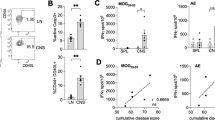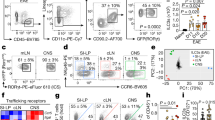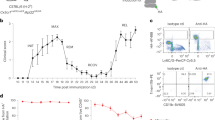Abstract
T lymphocytes specific for myelin basic protein (MBP) are responsible for the cellular events leading to autoimmune disease within the central (CNS) and peripheral (PNS) nervous systems. Both in actively induced and T-cell transfer versions of experimental autoimmune encephalomyelitis (EAE) and neuritis (EAN), the autoaggressive T cells are activated outside the nervous system and reach their target tissue via the blood circulation. The target specificity of the autoaggressive T cells is impressive; T-cell lines specific for MBP predominantly home to and affect the white matter of the CNS1–3 whereas T cells specific for PNS myelin protein P2 exclusively infiltrate peripheral nerves4,5. Having penetrated the tight blood tissue barriers, the lymphocytes seem to interact with local cells expressing the relevant autoantigen in an immunogenic form. Although the exact mechanism of target finding and destruction is unknown, studies from our laboratory have shown that astrocytes, a main component of the normal CNS glia, can actively present antigen to specific T cells6,7. This observation suggests that astrocytes are involved in natural immune reactivity within the CNS, and that they may be involved in pathological aberrations, such as in the development of autoimmune lesions. Having studied astrocyte/T-cell interactions in more detail, we discovered that encephalitogenic T-cell lines recognizing MBP on astrocytes will subsequently proceed to kill the presenting cells. Here we report that astrocyte killing follows the rules governing ‘classical’ T-cell-mediated cytolysis; it is antigen-specific, restricted by antigens of the major histocompatibility complex (MHC) and apparently contact-dependent. Our data suggest that the nature of the recognized antigenic epitope determines whether or not antigen recognition is followed by killing; moreover, killing of antigen-presenting astrocytes seems to be correlated with the capacity to transfer encephalomyelitis to normal syngeneic rats.
This is a preview of subscription content, access via your institution
Access options
Subscribe to this journal
Receive 51 print issues and online access
$199.00 per year
only $3.90 per issue
Buy this article
- Purchase on Springer Link
- Instant access to full article PDF
Prices may be subject to local taxes which are calculated during checkout
Similar content being viewed by others
References
Ben-Nun, A., Wekerle, H. & Cohen, I. R. Eur. J. Immun. 11, 195–199 (1981).
Wekerle, H. Lab. Invest. 51, 199–205 (1984).
Swanborg, R. H. J. Immun. 130, 1503–1505 (1983).
Linington, C. et al. J. Immun. 133, 1946–1950 (1984).
Izumo, S., Linington, C., Wekerle, H. & Meyermann, R. Lab. Invest. (in the press).
Fontana, A., Fierz, W. & Wekerle, H. Nature 307, 273–276 (1984).
Fierz, W., Endler, B., Reske, K., Wekerle, H. & Fontana, A. J. Immun. 134, 3785–3793 (1985).
BenNun, A. & Cohen, I. R. J. Immun. 129, 303–308 (1982).
Mason, D. W. et al. Immun. Rev. 74, 57–82 (1983).
Schluesener, H. J. thesis, Univ. Würzburg (1984).
Holoshitz, J., Naparstek, Y., Ben-Nun, A., Marquardt, P. & Cohen, I. Eur. J. Immun. 14, 729–733 (1984).
Biddison, W. E., Rao, P. E., Talle, M. A., Goldstein, G. & Shaw, S. J. exp. Med. 156, 1065–1076 (1982).
Krensky, A. M., Reiss, C. S., Mier, J. M., Strominger, J. L. & Burakoff, S. J. Proc. natn. Acad. Sci. U.S.A. 79, 2365–2369 (1982).
Meuer, S. C., Schlossman, S. F. & Reinherz, E. L. Proc. natn. Acad. Sci. U.S.A. 79, 4395–4399 (1982).
Spits, J., Borst, J., Terhorst, C. & deVries, J. E. J. Immun. 129, 1563–1579 (1982).
Cerottini, J.-C. & MacDonald, H. R. J. Immun. 126, 490–496 (1981).
Tite, J. P. & Janeway, J. A., Eur. J. Immun. 14, 878–886 (1984).
Roller, G. (ed.) Immun. Rev. 74 (1983).
Jacobson, S., Nepom, G. I., Richert, J. R., Biddison, W. G. & McFarland, H. J. exp. Med. 161, 263–268 (1985).
Fleischer, B. Nature 308, 365–367 (1984).
Jahnke, U., Fischer, E. H. & Alvord, E. C. Science 229, 282–284 (1985).
Wong, G. H. W., Bartlett, P. F., Clark-Lewis, I., Battye, F. & Schrader, J. W. Nature 310, 688–691 (1984).
Paterson, P. Y. Fedn Proc. 35, 2428–2434 (1976).
Yarom, Y. et al. Nature 303, 246–248 (1983).
Brosnan, C. F., Bornstein, M. B. & Bloom, B. R. J. Immun. 126, 614–620 (1981).
Cammer, W., Bloom, B. R., Norton, W. T. & Gordon, S. Proc. natn. Acad. Sci. U.S.A. 75, 1554–1558 (1978).
Omlin, F. X., Webster, H. de, F., Palkovits, C. G. & Cohen, S. R. J. Cell Biol. 95, 242–248 (1982).
Lisak, R. P. et al. Brain Res. 289, 285–292 (1984).
McCarran, R. M., Kempski, O., Spatz, M. & McFarlin, D. E. J. Immun. 134, 3100–3103 (1985).
Vass, K., Lassmann, H., Wekerle, H. & Wisniewski, H. Ann. Neuropath. (in the press).
Duffy, P. E. Astrocytes Normal, Reactive and Neoplastic(Raven, New York 1983).
Chou, C.-H. J., Chou, F. C.-H., Kowalski, T. J., Shapira, R. & Kibler, R. F. J. Neurochem. 28, 115–119 (1977).
McMaster, W. R. & Williams, A. F., Eur. J. Immun. 9, 426–433 (1979).
Fukumoto, T., McMaster, W. R. & Williams, A. F. Eur. J. Immun. 12, 237–243 (1982).
Author information
Authors and Affiliations
Rights and permissions
About this article
Cite this article
Sun, D., Wekerle, H. Ia-restricted encephalitogenic T lymphocytes mediating EAE lyse autoantigen-presenting astrocytes. Nature 320, 70–72 (1986). https://doi.org/10.1038/320070a0
Received:
Accepted:
Issue Date:
DOI: https://doi.org/10.1038/320070a0
This article is cited by
-
Pathophysiology of the blood-brain barrier
Springer Seminars in Immunopathology (1996)
-
Peptide determinants of myelin proteolipid protein (PLP) in autoimmune demyelinating disease: A review
Neurochemical Research (1994)
Comments
By submitting a comment you agree to abide by our Terms and Community Guidelines. If you find something abusive or that does not comply with our terms or guidelines please flag it as inappropriate.



